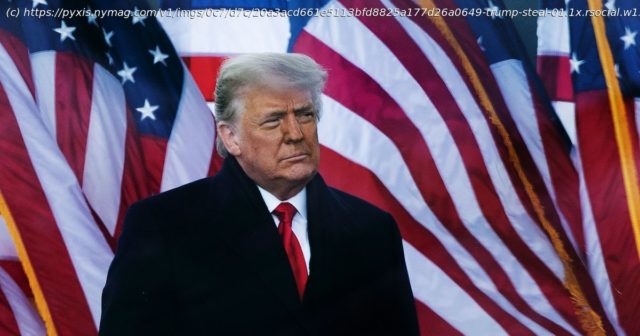The insurrection isn’t just the January 6 Capitol Riot. It’s a yearslong plot by Trump involving false voter-fraud claims, delegitimizing mail ballots, pressuring the DOJ, and pushing Mike Pence to toss electoral votes. And it isn’t over.
In the year since the Capitol Riot, the House select committee investigation and various media reports explaining what Donald Trump and his allies were doing in the days immediately leading up to the attack have cast new light on an important threat to American democracy. But the intense focus on a few wild days in Washington can be misleading as well. Trump’s campaign to steal the 2020 presidential election began shortly after the 2016 election, and arguably the moment of peak peril for Joe Biden’s inauguration had already passed by the time Trump addressed the Stop the Steal rally on January 6. A full timeline of the attempted insurrection is helpful in putting Trump’s frantic, last-minute schemes into the proper context and countering the false impression that January 6 was an improvised, impossible-to-replicate event, rather than one part of an ongoing campaign. If Congress fails to seize its brief opportunity to reform our electoral system, the danger could recur in future elections — perhaps with a different, catastrophic outcome. November 27,2016 – November 3,2020 This wasn’t just a tossed-off random Trumpian fabrication. His insistence that Democrats had deployed ineligible (and probably noncitizen) voters led to his appointment of a Presidential Advisory Commission on Election Integrity in May 2017. The commission was ostensibly led by Vice-President Mike Pence but was more closely identified with its co-chairman Kris Kobach, the immigrant-bashing, vote-suppressing secretary of State of Kansas. As David Daley explains, it was a wide-ranging fishing expedition that caught exactly zero fish: Kobach’s plan was easy to discern: The commission was to be the front through which a cabal of shadowy Republican activists and oft-debunked academics, backed by misleading studies, laundered their phony voting-fraud theories into a justification for real-world suppression tactics such as national voter ID and massive coast-to-coast electoral-roll purges. The commission was soon disbanded empty-handed, with Kobach & Co. blaming its failure on noncooperation from states that refused to turn over voters’ personal information. But in MAGA Land, wild voter-fraud claims become more credible each time they are repeated, so the commission was a sound investment in future lies. In an effort to spin Republican losses in the 2018 midterm elections, House GOP leaders Paul Ryan and Kevin McCarthy seized on four contests in California in which Republicans led in early vote counting but lost when late mail ballots came in. Without alleging (much less proving) anything in particular, congressional Republicans suggested skullduggery in what was a normal trend in the counting of entirely legal ballots signed and mailed before Election Day but received afterward. I dismissed this GOP spin, which McCarthy was still pushing a year later, but warned that “all this ex post facto delegitimization of elections that [Republicans] lost sounds like a dress rehearsal for how they’ll behave if they do poorly again next year.” The president himself made similar allegations after the 2018 midterms, though he focused on two races the GOP eventually won. On Veterans Day, Trump declared that Florida’s Senate and governor’s race should be called in favor of the Republicans who were ahead on Election Night, though legally cast overseas military and civilian mail ballots had yet to be counted. He tweeted, falsely, that these “massively infected” ballots had shown up “out of nowhere” and thus must be ignored: The Florida Election should be called in favor of Rick Scott and Ron DeSantis in that large numbers of new ballots showed up out of nowhere, and many ballots are missing or forged. An honest vote count is no longer possible-ballots massively infected. Must go with Election Night! This did, indeed, turn out to be a dress rehearsal. Trump went on to make almost identical charges about late-arriving (or just late-counted) mail ballots on Election Night 2020. As the COVID-19 pandemic spread in 2020, states holding primaries and special elections naturally began liberalizing opportunities to vote by mail. Trump went bananas on Twitter in May, threatening to withhold federal funding from Michigan because its secretary of State had sent absentee-ballot applications to all registered voters. Twitter, in what was then an unprecedented action, took down two Trump tweets in which he mendaciously attacked California for “sending Ballots to millions of people, anyone… no matter who they are or how they got there.” Actually, of course, the ballots went only to registered voters. Trump’s goal seemed clear: By asserting that voting by mail is tantamount to voter fraud, he was setting up a bogus justification for contesting election results in any state he lost. Team Trump’s parallel strategy was to get Republicans to eschew voting by mail to ensure that the votes most often counted first (in-person Election Day ballots) would skew red as forcefully as possible (which is why one analyst dubbed the scheme the “Red Mirage”). As Election Day approached, there were many signs that, simply by attacking voting by mail as illegitimate, Trump was succeeding in discouraging his supporters from voting that way, thus producing the desired Election Night “skew” in his favor. In September, Trump’s hostility to mail ballots and threats to just claim victory became more intense and regular. In his first debate with Biden, on September 30, the plan to contest any election loss was made plain. Following an incoherent diatribe recapping his unfounded claims of rampant voter fraud, Trump was pressed on whether he would urge his supporters to “stay calm” and “not engage in any civil unrest” during the ballot-counting process, which would likely be drawn out due to unprecedented levels of voting by mail. “Will you pledge tonight that you will not declare victory until the election has been independently certified?” moderator Chris Wallace asked. “I’m urging my supporters to go into the polls and watch very carefully,” Trump replied. “If it’s a fair election, I am 100 percent onboard. But if I see tens of thousands of ballots being manipulated, I can’t go along with that.” November 4,2020 – January 5,2021 With Trump ahead but giving up ground in a number of states he would ultimately lose, he made his long-awaited play. At around 3 a.m. on November 4, he concluded his remarks to his supporters by saying: This is a fraud on the American public. This is an embarrassment to our country. We were getting ready to win this election. Frankly, we did win this election. We did win this election. So our goal now is to ensure the integrity for the good of this nation. This is a very big moment. This is a major fraud in our nation. We want the law to be used in a proper manner. So we’ll be going to the U.S.






